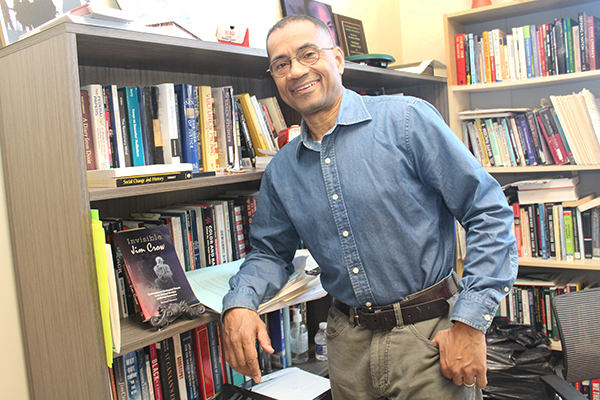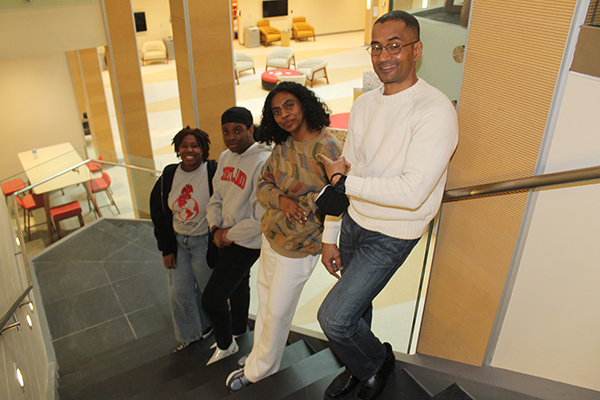
04/22/2025
SUNY Cortland Professor and Chair of Africana Studies Michael Tillotson didn’t plan to develop a comprehensive theoretical construction illuminating why people of African descent must move toward building their internal agency.
But he did. As a result, his Agency Reduction Formation (ARF) theory unintentionally became a widely used model in African American studies.
“I am an accidental theorist. I didn’t set out to develop theoretical constructions,” said Tillotson, who for the last three years has been a monthly recurring panelist on the regional public television program, WCNY-TV’s “Ivory Tower,” where he soon will join other upstate New York academics to talk about current events Tuesday, April 29, during a special, full-hour discussion taking place on the SUNY Cortland campus.
Since his theory was introduced, ARF has been presented in academic papers at Black studies conferences, been the subject of conference panel discussions and academic journal articles, master’s theses and doctoral dissertations. Over just the last two years, ARF will have served as the focus of four separate, daylong symposiums at universities in Indiana, Tennessee, Delaware and Illinois.
“Agency Reduction Formation meets the moment and responds at a critical time as many Black people are re-thinking their role in helping build collective efficacy to respond to the current political architecture,” stated Serie McDougal, an Africana studies researcher and scholar from California State University-Los Angeles.
In only the latest example, Tillotson’s theory — with an operational definition of “any system of thought that distracts, neutralizes or reduces the need and desire for assertive collective agency by African Americans” — was the Presidential Plenary topic on March 22 during the 49th annual conference of the National Council for Black Studies in Cincinnati, Ohio.
At the Presidential Plenary, three noted scholars discussed his theory, its use and application: Valerie Grim, professor of African American and African diaspora studies at Indiana University, Bloomington; Stephen Finley, Board of Trustees Distinguished Professor of Africana Studies at Louisiana State University; and Charisse Burden-Stelly, associate professor of African American studies at Wayne State University in Michigan.
“It is the highest point of my academic career thus far to have my peers and my colleagues in my discipline use my work in their scholarship, have their students use my work for master’s theses and dissertations and to be in a crowded plenary ball room with colleagues and witness them discussing my work,” said Tillotson, who earned a Ph.D. from Temple University’s African American Studies Department, the birthplace of doctoral-level African American studies.
“It was also rewarding that — for the first time in SUNY Cortland’s history — I was able to take three Africana majors and minors to experience the conference and also to present their own work and be around scholars that they have studied,” he said of the SUNY Cortland students Andrew Morene, Kyla Young and Anahis Mercedes.

Tillotson’s theory was introduced in his book, Invisible Jim Crow: Contemporary Ideological Threats to the Internal Security of African Americans (2011), soon after he had completed a post-doctoral fellowship in the African American Studies program at the University of Houston.
“As research-oriented academics know, you write something — a peer-reviewed article or monograph or a book — and then you move on to the next project,” Tillotson said.
“But sometimes the ancestors work in mysterious ways because this current attention to ARF is happening many, many years after the first book was published. Out of nowhere I started getting emails and phone calls and texts and voicemails from colleagues telling me that scholars are not just citing the theory but this person is using my theory as a launch point for their master’s thesis or that person is using my theory as a platform for their dissertation,” he said.
The next thing he knew, the theory was being used as a call for papers for the International Journal of Africana Studies. The next year, a panel of four scholars examined it at the annual conference of the National Council of Black Studies in Los Angeles. Two years ago, Indiana University in Bloomington held the first all-day ARF symposium.
Since Invisible Jim Crow, Tillotson has broadened his research to encompass the worldwide Africana experience in 14 peer-reviewed articles in leading Africana studies journals.
“It’s just an exciting time for Africana studies, because in this current moment, egalitarians are looking for race-specific information that can speak to the unique challenges of Africana people, in general, and Black Americans in particular,” Tillotson said.
Tillotson said his theory was part of his response to the critical need for a conceptual counter argument that addresses the challenges of Africana people due to factors crossing both time and geography, such as invasion, annexation, division and exploitation.
“Therefore, as a researcher coming out of the applied school of thought in the discipline, I was equally convinced that the negative disparities in the quality-of-life indicators for people of African descent could not simply be the singular result of members of this population not living up to their human potential,” Tillotson said.
“I clearly understood the X and Y axis, i.e. independent and dependent variable, explanations on Black life put forth by the expositors of the anti-egalitarian project were too binary and simplistic for my understanding. Therefore, I set out to investigate the confounds, or the Z factors, existing in the larger explanatory horizons of restrictive ideologies.”
Agency Reduction Formation provides that sorely needed Africana studies diagnostic.